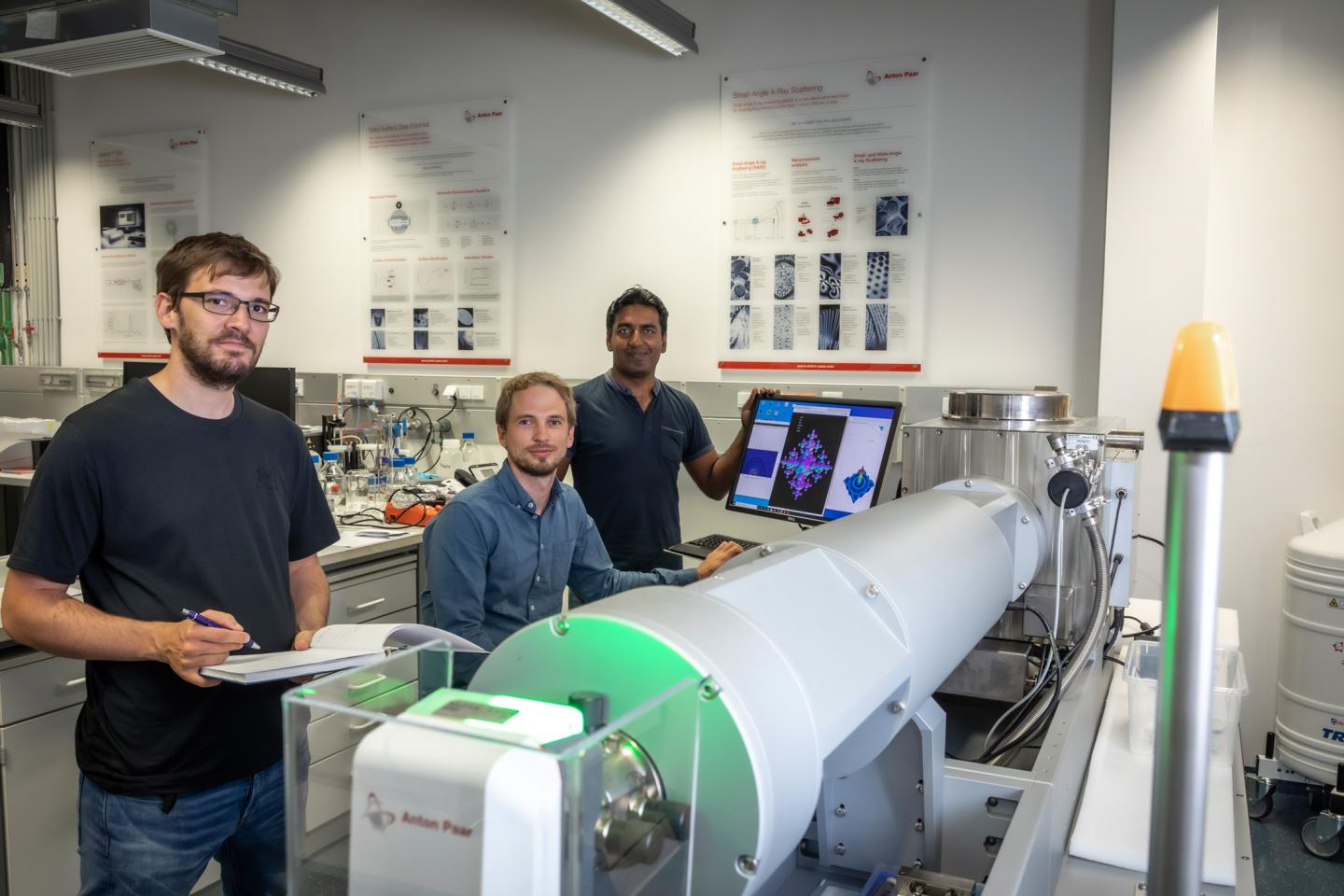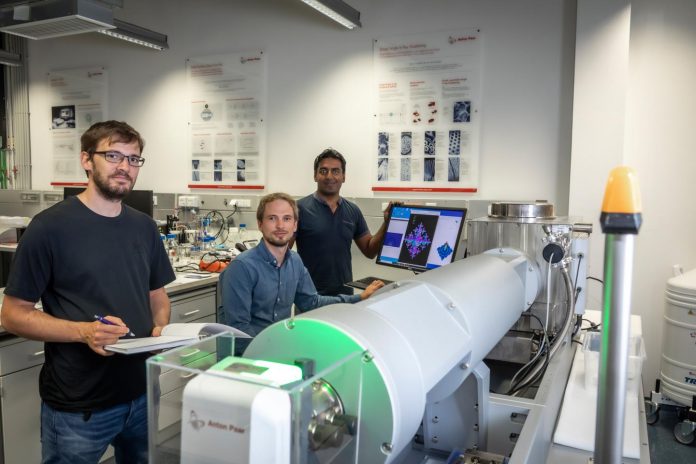
Photo: Harald Fitzek, Christian Prehal and Qamar Abbas (from left) at the SAXS facility SAXSpoint 2.0 (Anton Paar GmbH): With their work at Graz University of Technology, the researchers are providing…
view more
Credit Image: © Lunghammer – TU Graz
Limited safety, sustainability and recyclability are key drawbacks of today’s lithium-ion battery technology, along with restricted availability of starting materials (e.g. cobalt). In the search for alternative electrochemical energy storage systems for use in e-mobility and for storing energy from renewable sources, a combination of battery and capacitor is very promising: the “hybrid supercapacitor”. It can be charged and discharged as quickly as a capacitor and can store almost as much energy as conventional batteries. In comparison to the latter, it can be charged and discharged much faster and much more frequently: while a lithium-ion battery achieves a service life of a few thousand cycles, a supercapacitor manages around one million charging cycles.
System made of carbon and salt water
A particularly sustainable, but so far quite unexplored variant of such a hybrid supercapacitor consists of carbon and aqueous sodium iodide (NaI) electrolyte, with a positive battery electrode and a negative supercapacitor electrode. Researchers at Graz University of Technology have now investigated in more detail how exactly the electrochemical energy storage in this supercapacitor works and what happens in the nanometer-sized pores of the carbon electrode, and have recently published their promising results in the scientific journal Nature Communications. “The system we are looking at in detail consists of nanoporous carbon electrodes and an aqueous sodium iodide electrolyte, in other words salt water. This makes this system particularly environmentally friendly, cost-effective, incombustible and easy to recycle,” explains Christian Prehal. He is the first author of the study and has recently moved from the Institute of Chemistry and Technology of Materials at TU Graz to ETH Zurich.
Unexpectedly higher energy storage capacity
With the aid of small-angle X-ray scattering and Raman spectroscopy, the researchers were able to show for the first time that solid iodine nanoparticles are formed in the carbon nanopores of the battery electrode during charging, which dissolve again during discharge. This corrects the previously suspected reaction mechanism and has far-reaching consequences, as Christian Prehal explains: “The degree of filling of the nanopores with solid iodine determines how much energy can be stored in the electrode. This enables the energy storage capacity of the iodine carbon electrodes to reach unexpectedly high values by storing all chemical energy in the solid iodine particles.” This new fundamental knowledge opens the way to hybrid supercapacitors or battery electrodes with incomparably higher energy density and extremely fast charging and discharging processes. Such hybrid capacitors have been very successfully investigated and further developed for several years by Qamar Abbas, currently a Lise Meitner FWF scholarship holder at the Institute of Chemistry and Technology of Materials and another main author of the study.
With targeted improvements, hybrid supercapacitors can now be put to use as a safe, non-flammable, cost-effective and sustainable alternative for stationary storage of electrical energy. This can be an attractive option especially for the storage of energy from photovoltaic cells in private households, for example.
New investigation method for electrochemical energy storage systems
The researchers achieved another breakthrough with regard to the investigation methods used. In Raman spectroscopy, the interaction of light with matter is used to gain insight into the structure or properties of a material. Small-angle X-ray scattering (SAXS) makes structural changes during electrochemical reactions visible. Both methods took place in operando, i.e. live during the charging and discharging of a specially developed electrochemical cell. “Both operando Raman spectroscopy and operando SAXS were performed for the first time on a hybrid supercapacitor with aqueous NaI electrolyte at the Institute of Electron Microscopy and Nanoanalysis (FELMI) and in the soft matter application lab at Graz University of Technology. For the operando SAXS investigation, we have developed a special measuring cell for batteries and electrochemical energy storage devices,” explains Prehal. The results of the work show that operando SAXS is ideally suited to follow structural changes in a supercapacitor or battery on the nanometer scale and directly “live” during charging and discharging. This new investigation method could therefore be widely used in future in the field of electrochemical energy storage.
###
Original publication:
Christian Prehal, Harald Fitzek, Gerald Kothleitner, Volker Presser, Bernhard Gollas,
Stefan A. Freunberger & Qamar Abbas: Persistent and reversible solid iodine electrodeposition in nanoporous carbons. Nature Communications, 2020, 11:4838.
https:/
The small-angle X-ray measurements were performed at the SAXS facility SAXSpoint 2.0 (Anton Paar GmbH) in the soft matter application (SOMAPP) lab at TU Graz.
This research is anchored in the Field of Expertise “Advanced Materials Science”, one of five stratetic research foci of TU Graz.
Contact:
Christian PREHAL
Formerly at TU Graz | Institute of Chemistry and Technology of Materials
Currently at ETH Zürich | Institute for Electronics
Phone +43 664 7923054
Email: [email protected]
Qamar ABBAS
TU Graz | Institute of Chemistry and Technology of Materials
Phone +43 316 873 32357
Email: [email protected]
https:/
TDnews (tunisiesoir.com)















